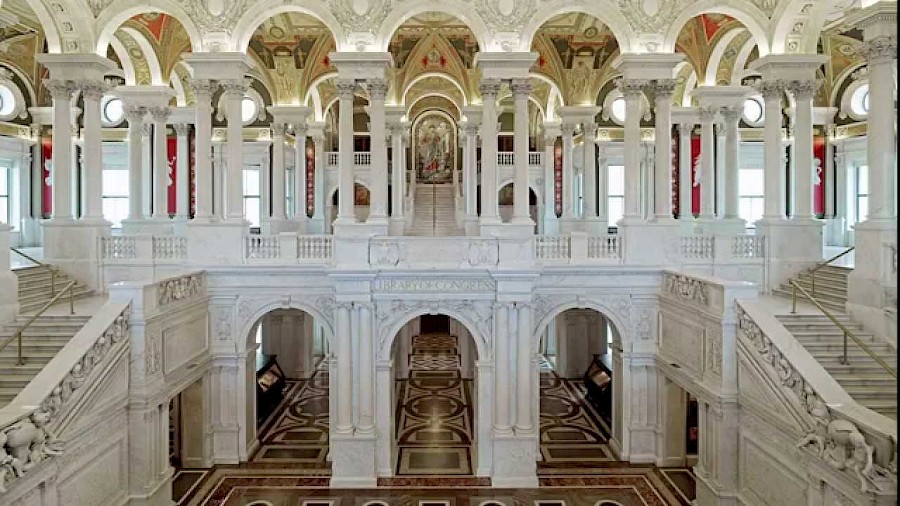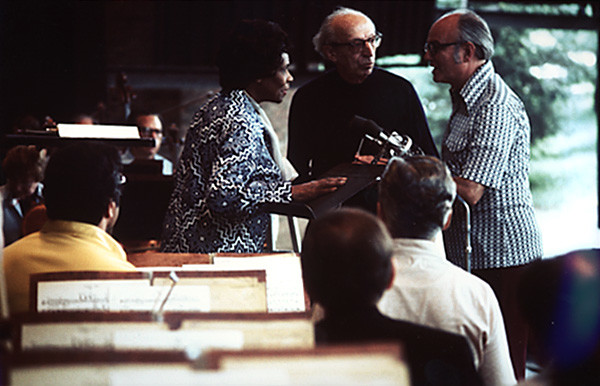It’s officially summer. For researchers of many stripes, busy schedules may relax enough to allow a pilgrimage to an air-conditioned archive. And if Copland is your interest, the Aaron Copland Collection at the Library of Congress (LoC) is the Promised Land of archives. (Or Nirvana. Or Mecca. Or Gold Standard; choose your own Elysian Field.) If, as I did recently, you find yourself in Washington D.C. with time for sleuthing in the Copland Collection, where do you start?
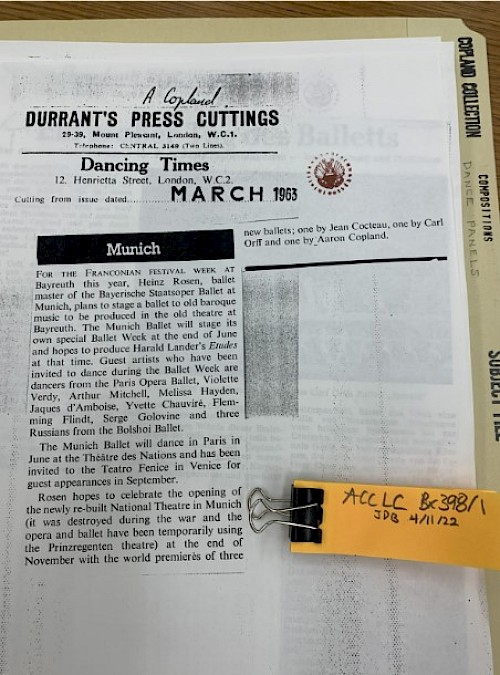
The Aaron Copland Collection (here, ACCLC) consists of about 400,000 items in 564 boxes, which would stretch nearly the length of a football field if lined up side by side. Copland had hired a series of assistants in the last 30 years of his career to help keep his papers organized. By 1989, his home in Peekskill NY contained not only the manuscript scores and sketches for most of his 200-some compositions, but also personal and professional correspondence, business documents, financial papers, diaries, scrapbooks and photos; books, articles and newspaper clippings by him and about him; and his own published scores marked up for conducting or corrections.
Toward the end of Copland’s life, all this came to the LoC, with his personal library of additional books and scores. Copland’s cat Helen came too, adopted in a privately arranged gesture of friendship by Betty Auman, then Head of Acquisitions and Processing for the Music Division. Musicologist Vivian Perlis, who knew the materials intimately from working on Copland’s autobiography, assisted with the transfer. LoC Specialists Wilda Heiss and Lloyd Pinchback managed a team of assistants who sorted, repackaged and catalogued the crates of incoming material. By the time the Collection opened to the public in 1995, its index alone (aka the Finding Aid) was the size of a telephone book.
Preparing to Visit
All this is fascinating, but how do you dive in? First, with a good research question. For my recent visit, I wanted to know, What can the ACCLC tell me, uniquely, about the origins and performance history of Dance Panels? This was a good question for an in-person trip because 1) published answers are few, brief, and/or difficult to find, and 2) the LoC’s primary sources about Dance Panels aren’t yet available online. It was a good question for a short trip because, as I learned from a quick search of the Finding Aid, all of Copland’s Dance Panels materials fit into two or three boxes.
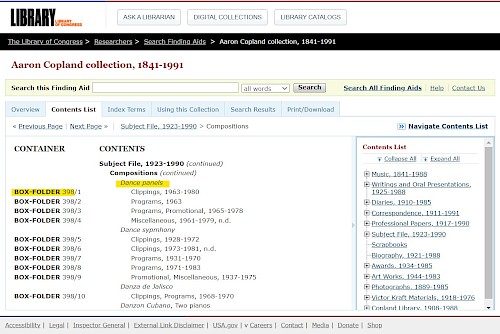
There are countless variations on this research question that I could pursue on a future visit. I could simply choose a different work. Or I could ask, what can the ACCLC tell me uniquely about Copland’s relationship to Composer A, Performer B, Patron C, or Public Figure D? Or, what can the ACCLC tell me uniquely about Copland’s connections to a given city, country, organization, or university?
I always keep in mind that the best questions for the ACCLC can’t easily be answered elsewhere. Yes, the LoC is taxpayer funded and available to all, but their mission is not that of a public library or a university library. They exist to supplement, not substitute for other libraries. Often have I heard LoC librarians repeat the mantra “We are a library of last resort.” So, I moved right on to the second preliminary step: background research.
At minimum, I knew I had to check three places: the LoC’s Online Copland Collection, Howard Pollack’s Aaron Copland: The Life and Work of an Uncommon Man (1999), and The Complete Copland, Copland’s autobiography co-written with Vivian Perlis (2013).* The Online Copland Collection includes five thousand high-quality, well-organized images of key items from the physical collection. The online collection’s curators picked 31 Copland works for special attention – Appalachian Spring, Fanfare for the Common Man, Short Symphony, Piano Variations, and others. Hundreds of digitized primary sources for these works can be viewed online. Dance Panels is not one of the 31.
Next was Pollack’s biography of Copland, which helpfully presents all the information about any given work together in one spot, in this case on pages 486-490. The Complete Copland’s references to Dance Panels are more scattered, but the book is indispensable as an update to the authoritative two-volume autobiography of 1984 and 1989. Both Pollack and Copland/Perlis provide accurate background drawn from various primary sources; however neither gave the kind of detail I knew I could glean from the ACCLC sources themselves. Some additional online searching confirmed my suspicion that no readily available journal articles or book chapters discuss Dance Panels’ primary sources in depth.
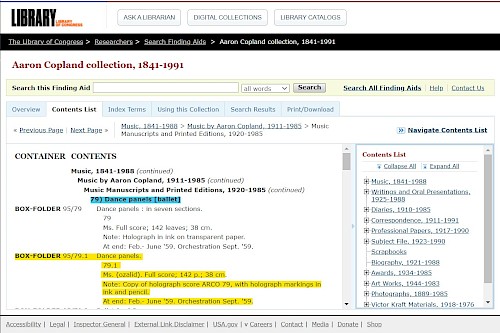
My last, most crucial virtual stop: the all-important Aaron Copland Collection Finding Aid. The Library of Congress website is vast and sprawling—a seemingly infinite virtual museum with thousands of rooms that thoroughly reward leisurely browsing. For focused, in-person Copland research, however, it helps to know where to look. Using the Finding Aid search box on my phone (on a computer, I find the pdf is easier to navigate), I searched for “Dance Panels” and in less than 3 minutes, I learned precisely what materials the ACCLC has on the work and what box numbers to write on my call slips. Most LoC stacks are closed to the public—certainly all of the archival collections are—so you have to fill out a call slip and ask the staff to retrieve each box for you. I requested Box 398 for press clippings and boxes 95 and 41 for the scores & sketches. This is typical. For most Copland works, there are two kinds of materials: folders of publicity in the “Subject File” and folders of notated music in the “Music by Aaron Copland” section.
On my first voyage to the Copland Collection long ago, I arrived with two letters of passage. One was from the Aaron Copland Fund for Music, which holds copyright for many of the ACCLC materials, granting me permission to photocopy items from the collection “for research purposes only”; permission to publish is a separate process. The second was a personal letter from a LoC Music Division staff member with whom I’d been corresponding who knew about my project and my plans to visit.
Nowadays, this page on the Copland Fund's website outlines the way to request permission to reproduce copyright materials. In most cases, LoC staff will allow research-only photocopies. This can be worked out in advance via the "Ask a Librarian" link found on the LoC Performing Arts Reading Room (PARR) page. It’s always best practice to send the PARR staff a message of self-introduction that describes your research question, mentions your background sources, lists the box numbers you’ve found, and asks for further advice. For my most recent visit, I wrote the staff a week ahead to check on pandemic protocols, and then used this link to request an appointment. I also found this FAQ page helpful.
On the Ground: Logistics and Inside Scoop
![Main entrance of the Madison Building at the Library of Congress. Library of Congress, Prints & Photographs Division, photograph by Carol M. Highsmith [LC-DIG-highsm-03178]](/site/assets/files/15567/loc_madison_building_main_entrance_photo_by_carol_m_highsmith.500x0.jpg)
The logistics for an in-person research visit are numerous, but not onerous. This page has the best overview. I skip over the “Main Reading Room” particulars (because that’s the wrong location for accessing Copland materials), though it is a stunningly restored historic space that I’ll make any excuse to visit. Rather, the ACCLC is accessed from the PARR in the Madison Building. As the web page explains, you can obtain—or update—the required Reader Registration Card in the Madison Building, which I find a less crowded and more convenient option.
Last April, at the time of my confirmed research appointment, I passed through security at the Madison Building main entrance. I proceeded left toward the coat check, where I left most of my belongings. I brought a large, clear plastic bag to carry the few things allowed into the PARR: pencils, IDs, credit card, USB stick, small notebook, cell phone, laptop, and chargers. To update my Reader Registration card, I continued down the same hall and around another corner to the Reader Registration desk inside the Periodicals Reading Room. Then I retraced my steps back past security to the opposite end of the hall, where I turned left down another hallway and proceeded to the PARR.
At the PARR welcome desk, I checked in with my ID, found out where to sit, and learned whether any special rules were in effect. I picked up blank call slips from the larger, central desk, filled them out, submitted them to the staff, and returned to my seat while the boxes were retrieved from the stacks below.
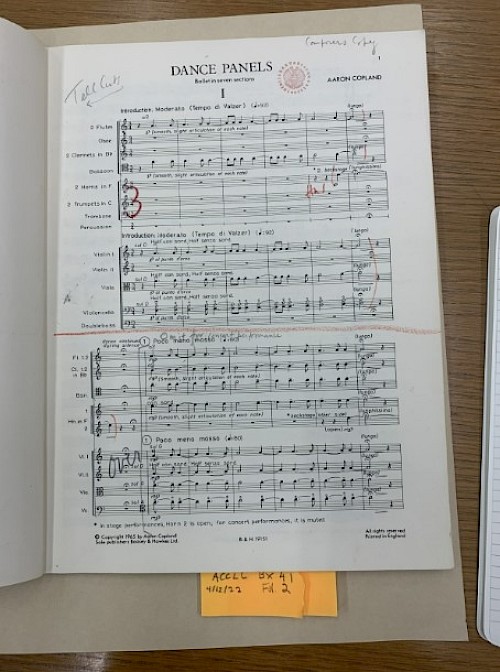
While I waited for the boxes, I reviewed my plan for recording my findings. I had my notebook and pencil, my cell phone for taking photos, and slips of paper to place in each frame to be marked with the box number, folder number, and date, for ease of future filing. I knew that if I needed a high-quality image of any particular archival item, the staff would first verify that the item wasn’t too fragile before pointing me toward the PARR’s high-quality scanning machines. The scanners aren’t connected to the internet, but I had my trusty USB thumb drive for saving images. Soon, the staff wheeled a small cart of boxes to my seat and reminded me of the rules: one box at a time, one folder at a time, no pens allowed, and handle carefully.
As I examined the boxes’ contents, I was once again swept up in the physical sensation of (gently!) handling one-of-a-kind documents touched by the composer himself. I noticed the tiny divots, the smudges, the creases at the corners. I imagined fingers precisely guiding a pencil as hand and wrist moved back and forth, up and down across this page, filling it slowly with ideas expressed in dots, lines and words. I realized that graphite catches the light differently than ink. Opening a conducting score, I saw thick, red-penciled lines and huge time signatures marking the same pages Copland turned on the podium of some of the world’s most famous concert halls. I tried not to indulge such unscholarly thoughts. Efficiency must prevail – I needed to finish quickly and return the box in time to submit one last call slip before the 4:30 deadline.
Conclusion
In-person research at the Aaron Copland Collection can be intense. Its size and scope are overwhelming. There are ever-shifting rules and procedures to follow. But within this formal environment, the PARR librarians are top-of-the-line experts: knowledgeable, active music scholars, well versed in how to help researchers find what they need. While all PARR staff can assist with the ACCLC, some specialist librarians are gold mines of knowledge about additional resources. The Online ACCLC description suggests closely related LoC collections to consult: Arthur Berger, Leonard Bernstein, Nadia Boulanger, Carlos Chávez, Elizabeth Sprague Coolidge. Those collections have their own online finding aids, where you can enter “Aaron Copland” and see what comes up. The more prepared I am, the more research trailheads the librarians can point out.
![Columbus Fountain and the exterior of Union Station, Washington, D.C. Library of Congress, Prints & Photographs Division, photograph by Carol M. Highsmith [LC-DIG-highsm-16432]](/site/assets/files/15569/columbus_fountain_and_union_station_photo_by_carol_m_highsmith.500x0.jpg)
To relieve the intensity, I take breaks. Since there are no windows in the public areas, if you want to see daylight, you have to leave the building. I’ll often grab a quick and healthy lunch at one of the restaurants two blocks down Pennsylvania Avenue, rubbing shoulders with staffers from the nearby Congressional office buildings, or just sit on the front terrace enjoying the gardens and stately white buildings of Capitol Hill. One out-of-town researcher I knew, James Dapogny, always left the PARR by 1 pm to spend afternoons in the Smithsonian museums on the National Mall, a pleasant 25-minute walk downhill to the west. I enjoy walking north past the Jefferson Building and the Supreme Court toward Union Station to catch the Red Line to the Maryland suburbs or Amtrak to New York City.
The subway, train, or airplane back home is a great time to organize and review my images. Then the job of interpreting the evidence and drawing conclusions can begin. However, the conclusions about Dance Panels await a future blog post, dear readers, so stay tuned.
*Additional important sources are listed in the Selected Bibliographies on this website; note especially the Berger and Smith biographies; and the Robertson/Armstrong and Skowronski guides to research, which are thorough through their dates of publication. For a good, updated online guide, see The University of Alabama Libraries website here.
Questions about accessing the Copland Collection or reproducing materials for publication? Contact the Fund using the form on our contact page. Please note: unpublished works in the Copland Collection were not authorized for publication by Mr. Copland. These works are not available for performance, recording or other public uses.

